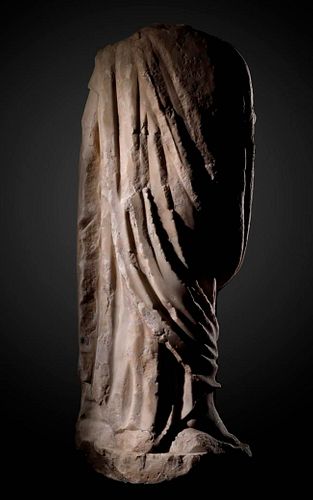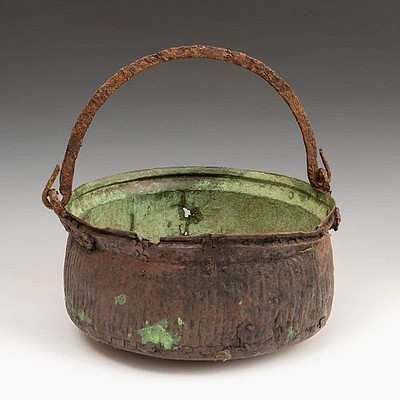Figure robed; High-Imperial Roman Art, I-II centuries AD. White marble. It has a French export permit. It presents damages caused by the passage of ti
Lot 97
About Seller
Setdart Auction House
Carrer Aragó 346
Barcelona
Spain
Setdart Subastas was born in 2004 and is currently the first online art auction in Spain with solidity, prestige and reliability guaranteed by our more than 60,000 users. Setdart has a young, dynamic and enterprising team ready to successfully manage the purchase and sale of art works through custom...Read more
Categories
Estimate:
EUR€120,000 - EUR€130,000
$129,032.26 - $139,784.95
Absentee vs Live bid
Two ways to bid:
- Leave a max absentee bid and the platform will bid on your behalf up to your maximum bid during the live auction.
- Bid live during the auction and your bids will be submitted real-time to the auctioneer.
Bid Increments
| Price | Bid Increment |
|---|---|
| EUR€0 | EUR€10 |
| EUR€200 | EUR€25 |
| EUR€500 | EUR€50 |
| EUR€1,000 | EUR€100 |
| EUR€3,000 | EUR€200 |
| EUR€5,000 | EUR€500 |
| EUR€10,000 | EUR€1,000 |
| EUR€20,000 | EUR€2,000 |
| EUR€50,000 | EUR€5,000 |
About Auction
By Setdart Auction House
Dec 22, 2021
Set Reminder
2021-12-22 08:30:00
2021-12-22 08:30:00
America/New_York
Bidsquare
Bidsquare : Archaeology, Session I
https://www.bidsquare.com/auctions/setdart-auction-house/archaeology-session-i-8050
Setdart Auction House sofia@setdart.com
Setdart Auction House sofia@setdart.com
- Lot Description
Figure robed; High-Imperial Roman Art, I-II centuries AD. White marble. It has a French export permit. It presents damages caused by the passage of time. Measures: 150 cm. Roman toga represented standing, with a tunic and over it a toga, the most characteristic garment of the Roman civilization. The figure appears standing, with a slight contrapostto, with the left hip slightly prominent, supporting his weight on the left leg while the right one appears slightly bent, in a resting position. In this elegant acephalous figure, the position turns slightly to the right, with the right foot turned to the left. The robe is partially covered by the toga and crosses the silhouette diagonally, creating deep folds and thus an attractive light-dark effect and density in the clothing. The toga, made of wool or other materials, was considered a sign of high social and economic status, reserved for the Roman elite. At the end of the first century BC, the toga suffered a decline in its use, but with Augustus it came back into fashion as a symbol of revitalization of the customs and values of Roman society. Large and heavy, the toga gave a solemn aspect to those who wore it, it supported and represented well the importance of Rome, sovereign of the ancient world. High Empire is the name usually given to the first half of the historical period covered by the Roman Empire, which includes its rise, in full expansion of the slave mode of production and all the expressions of classical civilization, under the system of government called Principate as established by Octavian Augustus at the end of the first century BC, until the dynasty of the Severi. Territorial expansion (which was already characteristic of the Republican period) continued in fact (annexation of border areas in direct contact with the barbarian peoples and with the Parthian Empire), although in theory expressed under concepts of containment and consolidation rather than aggressiveness (Pax romana, limes). The progressive extension of Roman citizenship throughout the provinces, as they became Romanized, included the promotion of provincial families to the highest honors and social ranks, up to the very imperial dignity. The transformation was undergone by the entire Mediterranean basin, but with notable differences in the western half (more Latinized) and the eastern half (where the Hellenistic influence continued and even deepened). After the Empire reached its maximum territorial dimensions at the time of the Antonines (second century), the crisis of the third century opened a period of decline that allows us to speak of the Lower Roman Empire, with other economic and social conditions (the transition from slavery to feudalism), and even with another system of government (the Dominate).It has a French export permit. It presents damages originated by the passage of time.
Condition
- Shipping Info
-
In-house shipping available. Please inquire at admin@setdart.com.
-
- Buyer's Premium



 EUR
EUR CAD
CAD AUD
AUD GBP
GBP MXN
MXN HKD
HKD CNY
CNY MYR
MYR SEK
SEK SGD
SGD CHF
CHF THB
THB













